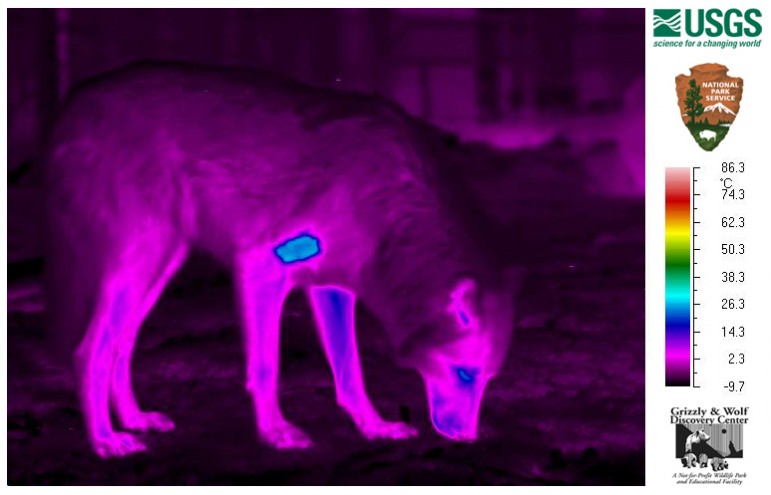
Thermal imaging reveals a bright blue patch near the shoulder of a captive wolf, whose fur was shaved to simulate the effects of sarcoptic mange.
A high-tech method for detecting disease in domestic cattle is helping researchers in Yellowstone National Park learn more about how sarcoptic mange effects gray wolf survival and behavior during the park’s long, cold winters.
Mange is a contagious disease among canines caused by mites that burrow into the skin, resulting in infections that bring irritation, persistent scratching and fur loss. Mange alone isn’t necessarily fatal, but it can leave wolves more vulnerable to dehydration, malnutrition and hypothermia.
Quantifying those ill effects among individual wolves in the wild has proven tricky, leaving researchers looking for a reliable way to take objective measurements.
For Paul Cross, a wildlife biologist with the U.S. Geological Survey, a moment of insight came when he learned how thermal imaging was used in the cattle industry to detect cows infected with foot-and-mouth disease.
The heat-sensitive cameras can pick up on the heat caused by related inflammation in a cow’s hoof within a day or two of contracting the disease.
“This was rolling around in the back of my mind, and I started thinking about what we can do with mange and thermography in Yellowstone,” Cross said in October during the 12th Biennial Scientific Conference on the Greater Yellowstone Ecosystem, held at Mammoth Hot Springs, Wyo.
Heat-sensing videocameras could help show the metabolic costs of mange in specific wolves, Cross realized. So he set up an experiment using rented and borrowed gear that would otherwise cost up to $100,000 to buy new.
For a control group, researchers shaved bald patches on captive wolves at the Grizzly and Wolf Discovery Center in West Yellowstone, Mont. This gave them a look at healthy skin temperatures that would not be visible due to fur, and offered insight about body heat lost due to bald patches. In the wild, Cross set up thermal videocameras near carcasses where Yellowstone wolves were feeding.
Cross said the project is one that could only be done in Yellowstone, where detailed conventional photography and other data gathered over many years by the Yellowstone Wolf Project helped researchers match well-documented individual wolves to their thermal images.
Video captured by Cross and his associates revealed that heavily infected sites on mangy wolves were significantly warmer than the rest of their bodies. That meant their metabolisms worked harder to generate heat, a problem made worse as wolves also lost body heat from patches of skin where fur was missing.
“As a warm-blooded animal, you don’t have the option of just getting colder,” Cross said. Some infected wolves may hang around thermal areas more than healthy wolves. And because wind can play such a big role in heat loss, it may influence which places infected wolves frequent or avoid as they look to escape freezing breezes.
Based on results from the thermal imaging study, mangy wolves in Yellowstone typically increase their food consumption by 10-30 percent, Cross said.
Mange first showed up in Yellowstone’s wolves in 2007, and it cycles throughout packs with varying intensities. Some animals handle it better than others, and it appears likely to affect how the highly social animals interact, hunt and mate.
Because mange is highly contagious and effects coyotes, foxes and wolves across the region, it’s unlikely the disease will be eradicated from Yellowstone. So researchers may be looking for more data from innovative techniques like thermal imaging cameras to better understand how mange and other diseases affect the complex dynamics of wolf packs in Yellowstone and beyond.
“Very few wolves die explicitly of hypothermia due to mange,” Cross said. “But mange can be one pretty good predictive factor of whether a wolf will die.”
Contact Ruffin Prevost at 307-213-9818 or ruffin@yellowstonegate.com.
